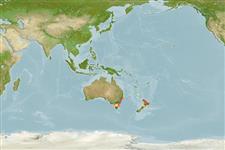Common names from other countries
Environment: milieu / climate zone / depth range / distribution range
Ecology
Marine; reef-associated; depth range 6 - 100 m. Subtropical; 25°S - 48°S, 140°E - 178°W
Southwest Pacific: southeastern Australia (New South Wales, Victoria, and Tasmania) and northeastern New Zealand.
Size / Weight / Age
Maturity: Lm ? range ? - ? cm
Max length : 11.7 cm SL male/unsexed; (Ref. 530); 8.6 cm SL (female)
Short description
Morphology | Morphometrics
Dorsal
spines
(total): 9;
Dorsal
soft rays
(total): 11;
Anal
spines: 3;
Anal
soft rays: 10;
Vertebrae: 25. Initial phase color: body red-orange above, paler posteriorly; with a white-bordered black ocellus at the base of the 9th and 10th dorsal rays. Terminal phase color: body deep crimson, paler below; pearly white stripe running from corner of mouth to caudal fin base; head with six bright blue lines. Predorsal scales 4 (3-5). Cheek scale 1 row behind the eye; 2 rows below eye. No scaly sheath at the base of dorsal and anal fins. Scales large. Pectoral fin with two rudimentary dorsalmost rays.
Occurs in sand patches adjacent to reef areas in shallow waters. The species is a facultative cleaner symbiont, removing parasites and damaged scales and skin from other fishes; also feeds on small crustaceans from the bottom and from seaweed fronds.
Life cycle and mating behavior
Maturity | Reproduction | Spawning | Eggs | Fecundity | Larvae
Oviparous, distinct pairing during breeding (Ref. 205).
Russell, B.C., 1985. Revision of the Indo-Pacific labrid fish genus Suezichthys, with descriptions of four new species. Indo-Pac. Fish. (2):21 p. (Ref. 530)
IUCN Red List Status (Ref. 130435)
CITES (Ref. 128078)
Not Evaluated
Threat to humans
Harmless
Human uses
More information
Age/SizeGrowthLength-weightLength-lengthLength-frequenciesMorphometricsMorphologyLarvaeLarval dynamicsRecruitmentAbundance
ReferencesAquacultureAquaculture profileStrainsGeneticsElectrophoresesHeritabilityDiseasesProcessingMass conversion
Tools
Can't connect to MySQL database fbquizv2. Errorcode: Too many connections
